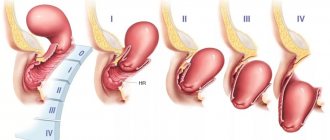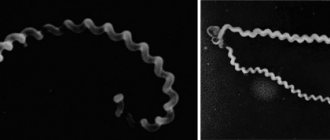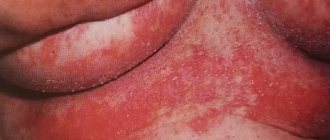Thrush, or candidal infection, accompanied by damage to the vaginal mucosa, is a problem for many women. The symptoms of this disease are so unpleasant that they completely knock the patient out of rhythm: due to severe itching, she cannot work normally, be sexually active, or even sleep peacefully.
THE COST OF AN APPOINTMENT WITH A GYNECOLOGIST IN OUR CLINIC IS 1000 rubles.
CLICK TO MAKE AN APPOINTMENT, TEST OR ULTRASOUND
Unfortunately, medications for thrush are advertised everywhere, which is why, having contracted candidiasis, women run not to the doctor, but to the pharmacy. After some time, the disease returns, which is natural, because such an infection cannot be cured with one pill; complex therapy is needed. That is why, at the first signs of thrush, you need to make an appointment with a good gynecologist and undergo full treatment. Today we will dispel myths about the treatment of thrush and formulate a number of recommendations that every woman should know.
Is thrush really a problem?
The content of the article
People of all ages suffer from candidiasis, with the peak incidence occurring between 20 and 40 years of age. According to statistics, 60% of women have been diagnosed with thrush at least once in their lives, and in 9%, candidiasis has a recurrent (repeating) course. In reality, this figure is higher, since in many patients the disease does not produce noticeable symptoms and the fungus is detected only when swabs are taken from the vagina.
The main problems of this pathology are self-medication, which leads to the disease becoming chronic, and negligent attitude towards one’s health. Gynecologists at the Diana Medical Center daily encounter cases of thrush, the severity of which is due to the patients’ late seeking of professional medical help.
Proper diet
To cure candidiasis in women and remove its consequences, it is advisable to combine medication with diet. The main goal is to deprive the Candida fungus of the nutrition it needs. Since this microorganism loves sugar and carbohydrates, first of all you should give up:
- sweet fruit juices;
- honey and other sweets;
- Sahara;
- corn, beets, potatoes, pumpkin, watermelon and other sweet fruits;
- alcohol.
But it’s worth adding more meat, unsweetened vegetables, nuts, eggs, fish, kefir, fermented baked milk and natural yoghurt to the menu.
By the way, this diet is useful for the prevention of candidiasis in women, so you can diversify your diet from time to time, even if you do not have thrush.
Why thrush develops: causes of candidiasis
The main cause of the disease is fungi of the genus Candida. Normally, the fungus lives in the body of any person, but under certain circumstances, as a result of the influence of various predisposing factors, it begins to actively multiply. Therefore, such microorganisms are called opportunistic.
Normal vaginal microflora keeps the fungus from excessively multiplying. When it changes (dysbiosis), the growth of Candida increases, and thrush .
Stimulate the activation of infection:
- hormonal changes in the body: pregnancy, menopause, diseases of the endocrine system (diabetes, thyroid problems), incorrect selection of birth control pills;
- violation of personal hygiene rules and wearing synthetic underwear - the fungus loves dampness, warmth and does not like fresh air;
- douching, using aggressive cleaning agents;
- the presence of sexually transmitted infections, inflammation of the internal female organs, infection with thrush from a partner;
- diseases accompanied by changes in the concentration of sex hormones in the blood,
- pregnancy and chronic foci of infection in the body, weakening the immune system;
- uncontrolled use of antibiotics, which destroy, along with parasitic flora, beneficial lactobacilli - protectors of the mucous membrane.
It’s easy to provoke candidiasis: just walk around in tight synthetic panties in the heat. The fungus develops instantly in such conditions - it loves moisture, warmth, and does not need air.
"Polyclinic +1" is the best choice
Taking care of the health and comfort of patients, we guarantee:
- sterility of biomaterial collection;
- efficiency, punctuality of diagnosis;
- exemplary quality of therapy;
- professionalism of doctors and laboratory technicians;
- personal selection of diagnostic methods and therapeutic treatment regimens;
- individual treatment plan during pregnancy;
- attention and friendliness of the staff;
- anonymity of tests, consultations, treatment;
- compliance with medical legislation;
- relevance of licenses and certificates.
We work seven days a week. Appointments can be made at a time convenient for patients by phone or on the Polyclinic +1 website. The clinic is located in the center of Moscow. There is parking nearby. Contact us - we will help maintain your health!
Is thrush contagious?
Keep in mind that candidiasis is a contagious disease and is easily transmitted to a sexual partner, so you will have to be treated together. The disease is often confused with an STD. In fact, thrush does not belong to this group, but contact with a man suffering from candidiasis will provoke the development of infection. A woman also transmits Candida to her partner. In men, thrush occurs more easily, this is due to good access of air to the mucous membrane of the head, but even without obvious signs, a once infected man becomes a carrier of the infection.
Symptoms of thrush: what a woman feels with candidiasis
Candidiasis is difficult to miss - it is one of the most unpleasant diseases. A woman is worried about incessant itching in the genital area, frequent painful urination (dysuria), pain and discomfort during sexual intercourse (dyspareunia), associated with vaginal dryness and injury. The main sign of fungal activity is a cheesy discharge. Whitish deposits begin to form on the reddened mucosa, which separate and form a cheesy vaginal discharge. In men, thrush manifests itself as redness of the head, a white coating accumulates on it, and red spots may form.
In advanced stages, the infection from the external genitalia spreads to the anal area. Cracks in the mucous membrane occur, accompanied by pain during defecation. If thrush is not treated, it becomes chronic and torments the woman constantly - during hypothermia, menstruation, after bathing, when personal hygiene rules are violated or in the premenstrual period, when hormonal levels change, etc.
Against the background of thrush, due to scratching and weakening of the natural flora of the vagina, a bacterial infection can develop, leading to bacterial vaginitis. Vaginitis quickly spreads to the uterus and its appendages, which in some cases can lead to decreased fertility (the ability to conceive), even to infertility.
If any symptoms of thrush appear, especially during pregnancy or breastfeeding, you should contact your doctor to confirm the diagnosis and prescribe timely treatment. The doctor makes a final diagnosis after receiving the test result (smear). A small amount of fungus does not cause disease and is normal.
Diagnostic methods
It is known that there are more than 70 species of yeast-like fungi of the genus Candida. Many of them can lead to painful symptoms, so a preliminary examination is extremely important to determine the correct and effective treatment.
To determine the causative agent of an infectious disease, a number of laboratory tests are required. Diagnosis of candidiasis includes the following methods:
- study of biological material (skin, mucus, plaque). For this purpose, skin scrapings and smears are prescribed, and scales, crusts or plaque from the mucous membranes are also taken for examination;
- hemotest to determine globulin levels. If their number exceeds the norm, then there is a high probability of infection;
- general tests: feces, urine, blood. Necessary for suspected systemic candidiasis.
If the gastrointestinal tract is affected by fungal microorganisms, an endoscopic examination is performed. It is often prescribed to collect material for subsequent detailed laboratory study. Your doctor may also prescribe a colonoscopy, bronchoscopy, or x-ray.
Diagnosis of thrush
Making a correct diagnosis is not a problem for an experienced doctor, but you will still have to take a smear to determine the purity of the flora. After all, thrush is rarely the only problem; as a rule, the analysis reveals a whole bunch of concomitant infections. Sexually transmitted infections are the cause of recurrent thrush in most cases.
To determine the best antifungal agent, the isolated fungi are inoculated and drugs are tested on them, determining the most effective one.
Essential oils
Essential oils are used to treat many diseases, including thrush. With their help, you can quickly get rid of the unpleasant symptoms of thrush, as well as reduce the activity of fungi and restore the vaginal microflora. They cannot be used in their pure form: essential oils are added a few drops to the main oil of plant origin.
Important! Before using essential oils, you must make sure that you are not allergic to them: to do this, apply a small amount of oil to the skin of the elbow - if after a few hours there are no changes, then you can begin treatment.
How to cure thrush with folk remedies using essential oils? First of all, it is necessary to select all the necessary components of treatment. All essential oils have healing properties, but tea tree oil and lavender oil are the best for thrush. They are mixed with grape seed oil, olive, sea buckthorn or almond oil. To create the mixture, you need to add about 10 drops of essential oil to 15 ml of base oil.
Advice. It is best to make tampons from a mixture of oils. To do this, you need to make a tampon from a medical bandage, lightly moisten it in a mixture of oils and leave it in the vagina overnight. If strong discomfort occurs, it is better to stop the procedure.
You can douche with warm water, to which add 2-3 drops of essential oil per 250 ml of liquid.
Treatment of thrush: only complex therapy
Contrary to popular belief, thrush is not cured with one pill. A doctor’s professional approach involves a set of measures.
The doctor selects antifungal drugs that can be taken:
- orally to reduce the amount of fungus throughout the body;
- in the form of suppositories or ointments locally - they quickly relieve the symptoms of candidiasis.
Treatment of thrush must necessarily include normalization of personal hygiene and treatment of STIs, if detected.
To combat Candida fungi, antifungal drugs are used, most often in the form of suppositories or a special vaginal gel. It is also necessary to take antifungal drugs internally. At the same time, the doctor will prescribe restorative therapy that restores immunity and normal vaginal flora. The patient is prescribed vitamins and immunostimulants that improve immunity. After completion of antibacterial therapy, the flora is restored with medications containing lactobacilli - this is the most important part of the beneficial microflora of the vagina.
Men will also have to take pills and treat the penis daily with a special solution or ointment prescribed by the doctor.
Prevention consists of rational use of antibiotics, regular visits to the gynecologist with taking smears for flora, strengthening the body, maintaining hygiene and refusing to wear synthetic underwear in hot weather.
The drug Clotrimazole
Clotrimazole is available in both ointment and tablet form. But the tablets are not intended for oral administration. They are used as suppositories, placed in the vagina. The active substance is clotrimazole. It disrupts the production of their main component by fungal cells. As a result, the fungus first cannot reproduce and then dies. The main advantage of vaginal tablets is their low cost.
The main contraindication to the use of Clotrimazole is pregnancy. In other cases, in the absence of allergic reactions to the drug, the drug can be used both at the first manifestations of thrush and in case of relapse.
Myths and truth about treating thrush
Myth No. 1. Thrush is normal!
The causative agent of thrush is fungi of the genus Candida, which are classified as opportunistic microorganisms. This means that they are contained in small quantities in the microflora of the body of healthy women. This fact leads some patients to believe that periodic manifestations of thrush do not deserve attention.
This is a misconception, because normally fungal pathogens do not cause unpleasant symptoms and do not bring discomfort to their owner. But in large quantities, Candida becomes dangerous, so thrush needs to be treated.
Myth No. 2. If thrush is not treated, it will go away on its own
This misconception, propagated on many websites, has led to the spread of chronic thrush among young women.
The primary symptoms of the disease - severe itching and curdled discharge, characteristic of the acute phase of the disease, indeed, even without treatment, gradually fade away. But this is a false sense of recovery. After some time, the troubles will return again - at the moment when the body experiences severe physical or psychological stress. In addition, the recurrence of thrush is facilitated by changes in hormonal levels, which occurs during menstruation and during pregnancy.
Myth No. 3. One tablet is enough to treat thrush!
The advertisement claims that after taking one capsule of the miracle drug, a woman will forever forget about the symptoms of thrush. Yes, the thrush may go away, but it will be replaced by severe dysbiosis, vaginosis and other diseases associated with disturbances in the vaginal microflora.
All antifungal agents used in the treatment of candidiasis (thrush) are drugs that specifically suppress pathological flora. At the same time, a safe drug should have a gentle effect on the mucous membrane without causing dysbacteriosis. In other words, he should treat smoothly, leaving time for the body to adapt. Whereas the “killer dose” will destroy both the causative agent of thrush and all living things, freeing up a springboard for colonization by new fungi and bacteria.
In addition, thrush rarely comes alone. Analysis (smear) sometimes reveals a whole bunch of STDs. In this case, combination treatment is required.
Myth No. 4. Local remedies for thrush are useless
Topical antifungal drugs quickly suppress fungal growth and play an important role in the treatment of thrush. Candles, creams, gels and sprays do not cause side effects and have no restrictions on use. But local therapy is considered by gynecologists exclusively as an additional measure, since it is effective only in the early stages of the development of pathology.
At the same time, suppositories and ointments are the drugs of choice in the treatment of candidiasis in pregnant and lactating women.
Myth No. 5. The appearance of thrush does not depend on lifestyle
The development of thrush always has a specific cause. Frequent stress, poor diet and heavy physical activity, which weaken the immune system, activate the fungal flora. Failure to comply with personal hygiene rules also affects the state of the vaginal microflora; in addition, the disease can be acquired by changing partners and using traumatic sex toys.
Another, perhaps significant reason is the uncontrolled use of antibiotics that affect the flora of the body. Broad-spectrum antibacterial drugs are not able to distinguish “bad” bacteria from “good” ones; they kill everything not only in the vagina, but also in the stomach and intestines. Therefore, lovers of self-medication are in for a surprise in the form of dysbiosis and accompanying candidiasis.
Myth No. 6. The most effective treatment for thrush is traditional medicine!
Traditional methods of treating candidiasis usually come down to the use of infusions and decoctions of herbs for washing and douching the vagina. For this purpose, herbs with antibacterial and antifungal effects are used.
These measures are good only as an aid to the main treatment, but thrush cannot be cured in this way. For quality treatment of vaginal candidiasis, you need to take antifungal drugs, immunostimulants and vitamins. Only this set of medications is guaranteed to reduce the likelihood of relapse of the disease.
Sources
- Urogenital candidiasis. Clinical recommendations. Moscow, 2016. - 22 p.m.
- Bayramova G.R., Amirkhanyan A.S., Chernova V.F. Vulvovaginal candidiasis: pathogenesis, diagnosis and treatment tactics // Doctor.Ru, 2018. - No. 10 (154). - P. 32-36
- Evseev A. A. Modern principles of diagnosis and treatment of vaginal candidiasis // Vestn. repr.. 2009. No. 2.
- Mayo Clinic Staff. (2015). Yeast infection (vaginal).
- Sherry L., Kean R., McKloud E., O'Donnell LE, Metcalfe R., Jones BL et al. Biofilms formed by isolates from recurrent vulvovaginal candidiasis patients are heterogeneous and insensitive to fluconazole // Antimicrob. Agents. Chemother, 2017; 61(9).
Where to cure thrush in St. Petersburg
It is more difficult to cure thrush than to prevent it. Lead a healthy lifestyle, avoid casual sex and observe personal hygiene rules - these simple rules will protect you not only from thrush, but also from other sexual diseases. And if thrush still strikes, seek professional help from the doctors at the Diana Multidisciplinary Medical Center in St. Petersburg.
CLICK TO MAKE AN APPOINTMENT, TEST OR ULTRASOUND
If you find an error, please select a piece of text and press Ctrl+Enter
Herbs
Many types of herbs are used as a remedy to treat thrush at home. Some of them have properties that prevent the proliferation of fungus, enhance tissue regeneration and restore the vaginal microflora. The most popular herbs in this category are calendula, chamomile, St. John's wort, yarrow, sage and string.
It is not recommended to use herbal infusions for prevention - abuse of such drugs can lead to vaginal dryness.
Herbs are usually used in the form of infusions or decoctions. To prepare the infusion, pour a tablespoon of raw material into a glass of boiling water and leave for about half an hour. The decoction is prepared from ingredients with the same proportions, boiled over low heat for 3-5 minutes, then left to cool. Before use, the finished liquid must be filtered thoroughly.
Herbs for thrush are used as douches, washes and for preparing baths. They can be combined, using in equal proportions, or you can prepare an infusion from only one type of plant.
Note. Their effect on the body is individual, so the best option can only be determined experimentally. However, the most effective herbs are chamomile and calendula - with their help you can cure thrush at home quite quickly.








